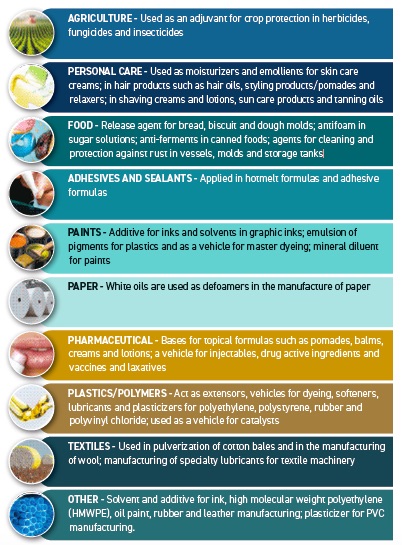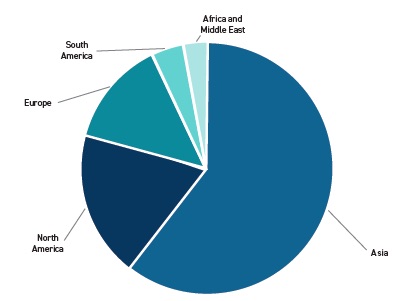Global white oils demand is expected to grow at a compound annual growth rate of 3.1% to reach almost 2.0 million tonnes by 2025, mainly due to the global economy recovering from the impact of COVID-19.
White oils—comprised of highly refined paraffinic or naphthenic base oils with extremely low aromatic content—are colorless, tasteless, odorless and hydrophobic and do not change color over time. They’re also known as light mineral oils, light liquid paraffin and light paraffin oils in different parts of the world.
White oils are used in various industries, and their functionality varies from one industry to another. Key white oil applications are described in Figure 1.
 Figure 1. Applications of white oils by industry.
The changes in white oils grades uses
Figure 1. Applications of white oils by industry.
The changes in white oils grades uses
White oils are produced in two quality grades: pharmaceutical and technical (or industrial) grade. Pharmaceutical grade is the most refined white oil, consisting of only branched alkanes and cycloalkanes and free from aromatic or unsaturated compounds. Quality standards for pharmaceutical-grade white oils in a country are usually set by the national pharmacopeia. However, standards set by the U.S. Pharmacopeia and the U.S. Food and Drug Administration for use in the food, pharmaceuticals and personal care industries are followed globally.
Pharmaceutical-grade white oils are mainly used in industries such as personal care, pharmaceuticals and food, as the end products of these industries are either ingested or come in contact with human skin. Earlier, pharmaceutical-grade white oils were used in equipment, where incidental contact with food, medicines or personal care products was possible. For all other equipment, technical-grade white oils were used. However, lately, for all equipment, only pharmaceutical-grade white oils are used irrespective of whether the lubricant can come in contact with end products or not. This approach is followed in most markets. Pharmaceutical-grade white oils also are used in industrial applications such as adhesives and sealants, and plastics, as they are used in packaging food, medicines and personal care products.
Technical-grade white oils are mainly used in non-food-contact industrial applications such as textile, plastics and adhesives and sealants, paper and agriculture. However, technical-grade white oils can be used in food, pharmaceutical and personal care industries, where white oils do not come in contact with end products in some markets, such as China.
Why pharmaceutical grades dominate
Pharmaceutical-grade white oils lead demand with more than 50% share due to a preference for pharmaceutical-grade white oils in the food, pharmaceuticals and personal care industries. They also have significant usage in the plastics and adhesives and sealants industries used for food, medicine and personal care products packaging, as previously noted.
However, there are regional variations. For example, in Europe and North America, pharmaceutical-grade white oil dominates the market, with more than three-fourths of market share. As a result, in these regions, end-users in industrial applications such as adhesives and sealants or plastics (not meant for food packaging) also use pharmaceutical-grade white oils. The end-users were already using pharmaceutical-grade white oils and have shifted to only using pharmaceutical-grade white oils. It also helps end-users project an image of being more health and safety conscious. And while pharmaceutical-grade white oils are more expensive than technical grade of white oils, the price difference is within the 5%-10% range, which is not cost prohibitive.
Global white oil demand
Global white oil demand was estimated at 1.7 million tonnes in 2020. Asia leads consumption, as it is the leading producer of plastics, textiles, pharmaceuticals and adhesives and sealants (the industries that are the largest consumers of white oils). Asia also is one of the biggest producers of personal care products globally. China and India are the two biggest markets for white oils in Asia. Asia is followed by North America and Europe, with plastics and personal care being two leading consumers of white oils in both regions. The U.S. is the largest market in North America, accounting for almost 95% of white oils demand in the region. In Europe, Germany is the leading consumer of white oils
(see Figure 2).
 Figure 2. Global demand for white oils by region, 2020.
Impact of COVID-19
Figure 2. Global demand for white oils by region, 2020.
Impact of COVID-19
The COVID-19 pandemic had an adverse impact on global white oils demand, causing an estimated 5% drop in 2020. The scale of decline varied from one country to another. The decreases, between 5% and 10%, were higher in developed markets such as Germany, the U.S., France and the UK, because these countries were among the most impacted during the first wave of COVID-19, experiencing temporary closures or reduction in production activities in various factories.
China and India also witnessed lessened demand of around 3% in 2020. However, in other Asian countries, such as South Korea, Japan and Indonesia, drops in demand were not significant for several reasons. For one, decreased demand in industries such as agriculture, textile and personal care in South Korea and Japan in 2020 was offset by increased demand in the food, pharmaceuticals and plastics industries. As a result, the decline in demand was less than 1% in both South Korea and Japan. Other countries, such as Brazil and South Africa, also witnessed minor decline in white oils demand in 2020.
The impact of COVID-19 on various industries differed. As consumers observed quarantine orders and purchased less makeup and clothes, demand for white oils decreased in the personal care and textile industries. Meanwhile, the closure of restaurants and bars led to a decline in white oils demand in the food industry, and the temporary closure of plastics and adhesives and sealants production facilities also led to declines. But the pharmaceuticals industry saw an increase in white oils demand. The reason: Pharmaceuticals production rose, with consumers purchasing more than their average number of medications during the pandemic.
Base oils
White oils are among the purest lubricants. Group I base oils need to undergo an extensive purification process before they can be used to produce white oils. This increases the cost of producing white oils from Group I base oils. Further, the supply of Group II base oils has increased while the supply of Group I base oils has decreased. As a result, white oil suppliers prefer Group II base oils over Group I due to the higher processing cost associated with the latter. Group II base oils also are preferred over Group III base oils, as the latter are more expensive than the former.
The choice of base oils to produce white oils also depends upon the availability. For example, the U.S. is the biggest producer of naphthenic base oils. Therefore, the usage of naphthenic base oils to produce white oils is higher than Group I and III base oils in the country. The demand for white oils in Indonesia and South Africa is met through imports; the base oils used to produce them depend upon their availability in countries such as India and South Korea, from where white oils are imported.
Where will white oils grow the most?
Lithium-ion battery separators is expected to be the fastest-growing application for white oils from 2020 to 2025, driven by increased interest in electric vehicles. The pharmaceuticals industry is expected to be the second fastest-growing application for white oils, driven by an aging population in Europe and countries such as Japan, as well as increasing healthcare coverage in countries such as India and South Africa.
Africa, the Middle East and Europe are expected to be the fastest-growing regions for white oils demand globally. Europe was the region most affected by COVID-19 and is, thus, expected to have faster growth rates as its economy recovers. Growth in Africa is expected to be faster due to income growth, leading to quicker growth in packaged food items and pharmaceuticals. This, in turn, will lead to higher growth in white oils demand. Asia will remain the biggest white oils-consuming region due to economic growth and the continued shift of the industrial production of plastics, paper and more to Asia.
In terms of grades, demand for pharmaceutical-grade white oils is expected to grow faster than technical-grade white oils. This will occur as white oils demand in the pharmaceuticals, food and personal care industries—which mainly use pharmaceutical-grade white oils—grows faster than white oils demand in industries such as adhesives and sealants, along with plastics, which uses technical-grade white oils in large quantities.
In terms of base oils, demand for Group III and II base oils for manufacturing white oils is expected to grow faster than demand for Group I and naphthenic base oils. This is mainly due to purity requirements and growth in the supply of Group II and III base oils.
The information is sourced from Kline’s recently published Global White Oils: Market Analysis and Opportunities, at
www2.klinegroup.com/white_oils_market, which assists white oil marketers in identifying opportunities within the global white oil industry. It also serves as an invaluable tool in the strategic planning process.
Kunal Mahajan is project manager, Kline Energy at Kline & Co. in the Energy practice. You can reach him at kunal.mahajan@klinegroup.com.
Kline is an international provider of world-class consulting services and high-quality market intelligence for industries that include lubricants and chemicals. Learn more at www.klinegroup.com.